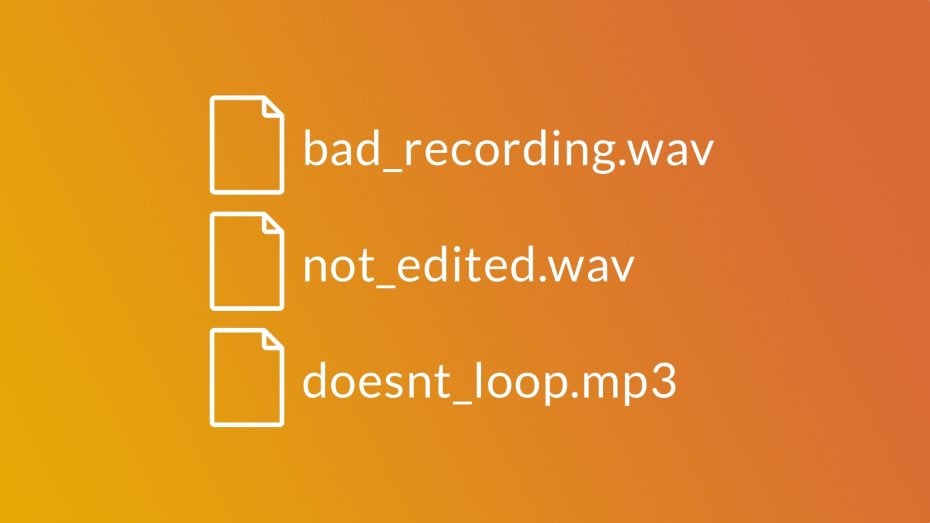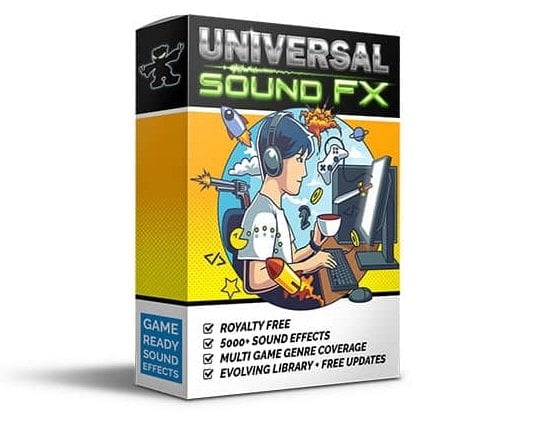There are plenty of free and paid sound effects available online but, unfortunately, while there’s definitely a lot of choice, not all of them will be any good for using in a game.
By trade I’m a game composer and I started offering sound design services a couple of years ago as well.
I’ve been really enjoying it and, now that I’ve had the chance to make a lot of different sound effects for games, I wanted to share some of the resources that I’ve found the most useful.
Where can you get good sound effects for your game?
There are three ways to get video game sound effects:
- Buy game-ready sound effects that can be added instantly to your game.
- Use licensed recordings from an audio library to create unique sound effects.
- Record your own audio to create sound effects from scratch.
In this article, I list my favourite places to get audio for sound effects, including some incredible free resources, as well as the equipment I use to record my own sounds and my recommended choices for game-ready sound packs.
Which method do I use to make sound effects for the games?
When I’m creating sound effects for clients, I prefer to use a mix of audio that I record myself and licensed source audio from libraries, as this gets usually me the best results and creates a completely unique sound effect.
However, I think that there are some great options for game-ready sound effects available that don’t require any work at all. You can just buy them, drop them in your project and you’re ready to go.
Unless you specifically want unique sounds or have special requirements for the sounds in your game, a game-ready sound effect pack is the best value and makes the most sense.
So that’s where we’ll start.
1. Buy game-ready sound effects
The best part about buying game-ready sounds is that they are exactly that. They’re ready to use, with no editing or converting required. Which is ideal if you don’t have the means to make or edit your own sound effects.
While convenient, the sounds will not, necessarily, be unique to your game, especially if the pack is very popular. However, due to the sheer variety of sounds available, especially if the product is occasionally updated with new sounds, I don’t see that it’s an issue.
There are a ton of sound effect packs available from all kinds of websites, however, in the interest of only recommending products that I’ve actually tried, here are a couple that I like:
Game-ready sound effect packs that I recommend
Universal Sound FX by Imphenzia ($40)
Stefan, or Imphenzia as he’s known, is a game audio veteran, having been an asset publisher for several years.
One of his flagship products, Universal Sound FX, was one of the first audio products to achieve real success on the Unity Asset Store and inspired my own product Ultimate Game Music.
If you’re looking for a simple solution for sound effects in your game, or if you just want a large stock of sounds to experiment with, I highly recommend Universal Sound FX.
- Universal Sound FX on the Unity Asset Store
- Universal Sound FX on the Unreal Marketplace
- Universal Sound FX official website
Casual Game SFX Pack by Dustyroom (Free)
Dustyroom are known, amongst other things, for their innovative procedural audio asset, Everloop, which was released to widespread acclaim a few years ago.
But they also released a free casual sounds pack too, which contains a useful selection of one shot sound effects designed for user interfaces.
Everything that Dustyroom makes sounds really very good, and their commitment to making high quality products is obvious in how they present their assets.
Because of the quality of everything they make, I have no trouble recommending this too.
Western Audio & Music (Free)
This one is mine. It’s a modest SFX pack but it’s free. Enjoy!
Other game-ready SFX packs
I’ll continue to update this list in the future with new packs that I’m willing to recommend.
Got a tip? Leave a comment and let me know!
2. Make unique sound effects using source audio
When I refer to source audio, I’m referring to professional grade recordings of objects, animals, weather, vehicles, usually recorded at a high bit depth and sample rate with the intention of being used in professional audio production for film, tv and, of course, games.
Typically source audio can’t just be dropped in to a project as it is. This is because the higher sample rate and bit depth will likely make the file much too large and, also, because the recording itself may be much longer than is needed, might include multiple takes and will probably not have been processed in any way.
What source audio does offer, however, is access to recordings that would be impossible or inconvenient for me to get otherwise. I can layer, edit and process source audio to create new, unique, sound effects with.
Audio libraries offer a balance of unique audio and convenience.
Say, for example, I wanted to record a gunshot, or a tiger’s roar, or even something simple, like forest ambience.
Well we don’t really have guns here (I live in the UK), I don’t know any tigers and the one time I tried to record forest ambience I couldn’t get far enough away from a road without it being picked up on the recording, even in the largest wooded area near my home.
Using source audio, however, I can layer, edit and process other people’s recordings to create new, unique, sound effects with.
Here are my favourite places to go for high quality source audio:
Sonniss
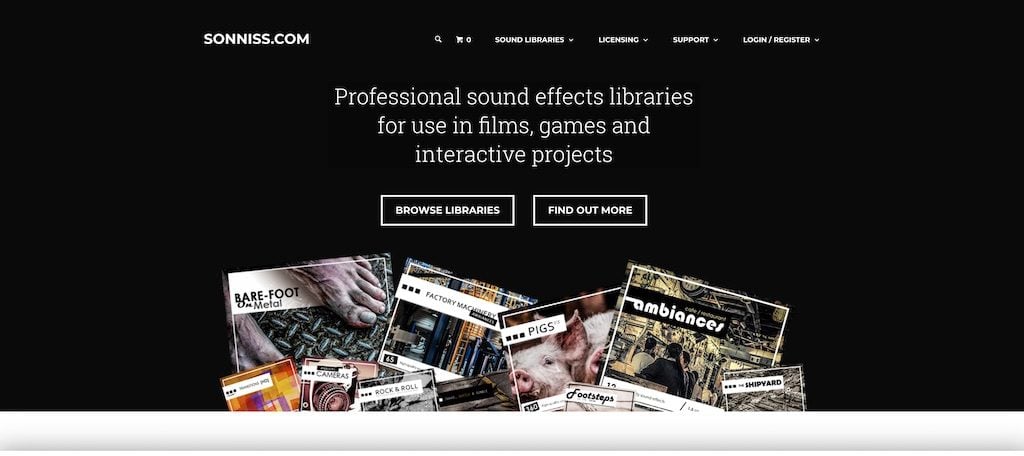
Sonniss give away a huge amount of free sounds every year to celebrate GDC.
They are at the top of this list for a big, big reason.
Every year, in celebration of GDC, Sonniss release a large selection of audio samples from their catalogue for free.
So for example, earlier this year they gave away 25GB of source audio. It’s high quality, the audio can be used commercially and doesn’t require any kind of registration to download. It’s an incredible offer.
But that’s not all,
They did the same thing in 2018, 2017, 2016 and 2015 and, at the time of writing this, most of those links still work! They appear to provide a support contact if they don’t.
If you want 90GB of high quality source audio to make sound effects with just visit these links and download it all:
- Sonniss GDC Giveaway 2016 (16GB)
- Sonniss GDC Giveaway 2017 (20GB)
- Sonniss GDC Giveaway 2018 (30GB)
- Sonniss GDC Giveaway 2019 (25GB)
While these sounds will not be suitable for just dropping into your project, It’s a fantastic way of building a starter library of source audio to make sound effects with, so long as you don’t mind a little editing.
Pro Sound Effects

I use Pro Sound Effects for sounds that I can’t record myself.
I use Pro Sound Effects whenever I’m working on a sound heavy project.
Their library of sounds is massive meaning that, if you can think of it, someone’s probably recorded it and is selling it on PSE.
They offer multiple pricing options that range from expensive (but better value) general purpose libraries to, much cheaper, one off downloads.
For my uses, I have a monthly subscription that gives me a number of download credits each month, rolling over if I don’t use them all. Then, if I need to cancel (e.g. if I get several music only projects lasting several months) I can stop paying for it for a while, and start my subscription again in the future when I need more sounds*.
* Be aware that you’ll need to use up any credits before you cancel to avoid losing them.
Pro Sound Effects is useful to me, not only because I can download any sound I want, but also because I can preview a sound, and hundreds of sounds that are similar, very easily.
This was incredibly helpful when I was a beginner, when I was still learning what textures and types of sounds would work well in a finished sound effect. Being able to browse hundreds of sounds easily helped me to experiment with ideas without having to actually buy anything or record anything.
Boom Library

Boom Library make high quality sound packs and give away samples in their newsletter.
Boom Library make high quality source audio packs for a range of uses.
They have a general purpose bundle, but they also specialise in themed packs. For example, Magic, vehicles, historically accurate firearms etc.
While their packages can be expensive (although much cheaper than buying a large general purpose library) the quality is fantastic and, what’s more, you can get samples of their packs by signing up to their newsletter.
They send out monthly samples for free which, although they usually only include a few sounds, are of high quality and are thoughtfully selected (you’ll actually use them).
3. Record and make your own sound effects
If you don’t like the idea of using other people’s recordings then you can always record your own sound effects instead.
It’s fun to do, gives you complete control over the sound you create and can be surprisingly affordable.
Software for editing and recording audio
I use Cubase for both music and audio editing as, despite being mainly music focussed, it’s also an extremely capable program for making sound effects with, as it shares many of the same features as its sound design counterpart, Nuendo.
While it is effective, it’s expensive. Stripped down versions are available but, even so, I wouldn’t necessarily recommend Cubase for sound effects (if you’re not already using it for music). This is because Cubase is just one of many, many audio editing options available on the market.
Using Cubase for sound design works well for me because I already own it anyway, I’m extremely familiar with how to use it and it offers many professional grade features and effects. More than enough for me to take on any sound design work I’m offered.
So what do I recommend then?
If you need a capable, free audio editor, and especially if you’re just getting started, just download Audacity.
It’s more than enough to get you started with basic audio editing and produces high quality results.
In fact, Audacity’s resampling algorithm was found to be as good as or better than many leading audio programs. Even, at the time at least, Cubase – Source.
And while it may be pig ugly – it sometimes reminds me of Windows Media Player skins from the 90s – it does work well and will allow you to familiarise yourself with audio editing, without spending any money.
Then, once you know what features you are likely to need in an audio editor, you can always upgrade to a paid option that might improve your workflow, make editing easier, or provide added features that you didn’t know you wanted before.
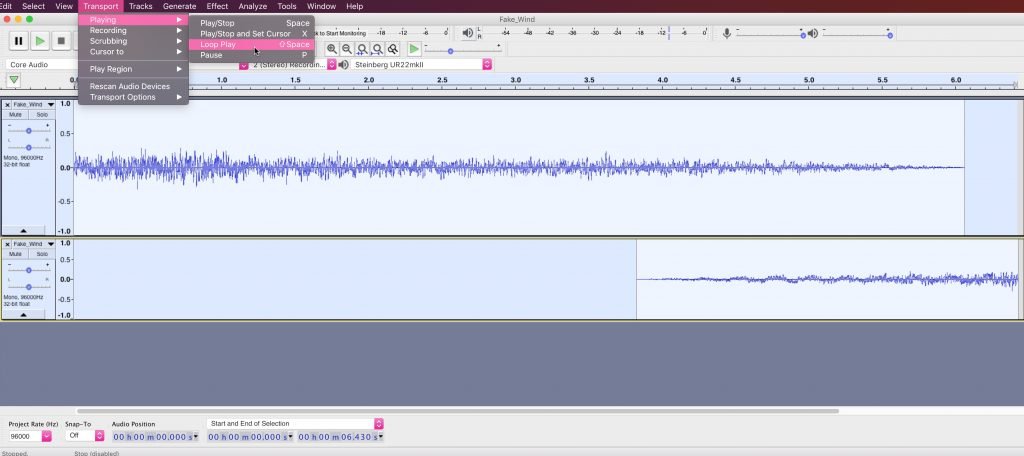
Audacity is a fully featured audio editor, that’s completely free.
Equipment for recording sound effects
If you’re going to record your own sounds, you’re going to need at least some equipment.
Audio gear can be extremely expensive, however I don’t believe that you need to spend thousands to get good results.
Far from it.
In fact all of my recording equipment has been quite affordable, especially compared to other investments I’ve made and the cost of software.
But, I’ve also been really happy with the quality.
This has been because, every time I’ve needed to buy something new, speakers, a microphone etc. a little bit of research has always revealed a stand out product. A product that, somehow, doesn’t compromise on quality but is genuinely affordable as well.
And then that’s what I buy.
So, if you’re thinking of recording your own sound effects, here’s the equipment you’ll need and what I ended up buying:
Microphones
Obviously you need a microphone to record audio.
The range of microphones I own is modest at best, but I’m really happy with what I bought.
Rode NT1
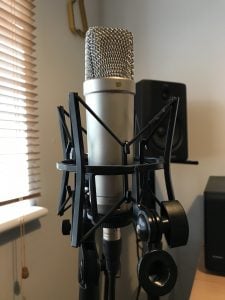
My Rode Nt1, in the included shock mount.
If there is such a thing as a good value all-purpose mic, this is probably it.
The build quality is great, it came with a bunch of accessories and it sounds fantastic.
It was also extremely affordable and, because it’s so versatile, it’s now my go to mic for just about everything I record in the studio. Amazingly, It also comes bundled with a stand, a shock mount and a pop shield, which is genuinely a good deal. Just check out this review from industry veterans, Sound on Sound.
I got my Rode NT1 in a recording bundle.
If you do buy this microphone, or one like it, keep in mind that you’ll need an audio interface, or some other recording interface that accepts an XLR input and supports phantom power.
Audio interface
An audio interface is often required for recording using studio grade microphones and will usually include a number of microphone specific ports (XLR) and jack inputs for recording with.
Very often it will also supply ‘phantom power’, which is 48v of power for active microphones (required for most studio mics).
My original audio interface was awful. It was a Peavey multi track mixer, more suitable for basic live mixing than studio work, and you could tell it wasn’t fit for purpose.
The biggest issue was that it was limited to 16bit, 44.1khz which, although fine as an output format, isn’t good enough for recording and working with.
So I bought a new audio interface, the Steinberg UR22 mkII, which I absolutely love.
UR22 MkII

My UR22 at home on my desk.
I got this because I knew the brand (it’s Steinberg branded but built by Yamaha I believe), it had fantastic reviews about its ‘best in class’ preamps (I’d suffered with really noisy recordings until buying this) and because it boasted one of the highest sample rates available at this price point, a whopping 192khz.
Why does a high sample rate matter?
Well usually it doesn’t.
Unlike changes in bit depth, which can be more noticeable, a higher sample rate is, arguably, difficult to notice above about 40khz. This is because a higher sample rate generally increases the highest frequency that can be produced (half that of the sample rate), while the highest frequency 44.1khz audio can produce is already above the upper limit of human hearing (which is around 20khz).
Generally speaking I agree with this, although I’ve seen people argue both in agreement and against it. But I’m not going to get into that here.
So why would I care about a higher sample rate then?
The first thing I realised when I started experimenting with sound effects was that I was pitch shifting sounds, a lot.
Pitch shifting down reduces quality, because the sample rate is, essentially, slowed down and reduced. This is less of an issue for lower pitched sounds, however, pitch down a metallic, high pitched recording at 44.1khz and you’ll quickly hear the degradation in quality.
Recording audio at a higher sample rate allows me to make extreme pitch adjustments without losing any detail at higher frequencies. This is because any loss of sample rate is cushioned by the fact that I’m recording at around four times the quality to start with.
I noticed an immediate improvement in the sound effects I was making so I definitely recommend it.
While I regularly enjoy the benefit of having a dedicated audio interface, if you’re just getting started, or only doing some light audio recording work, it’s an added expense.
There is, however, another recording option that still uses high quality microphones but that doesn’t require an audio interface at all.
Portable recorders.
Zoom H4N
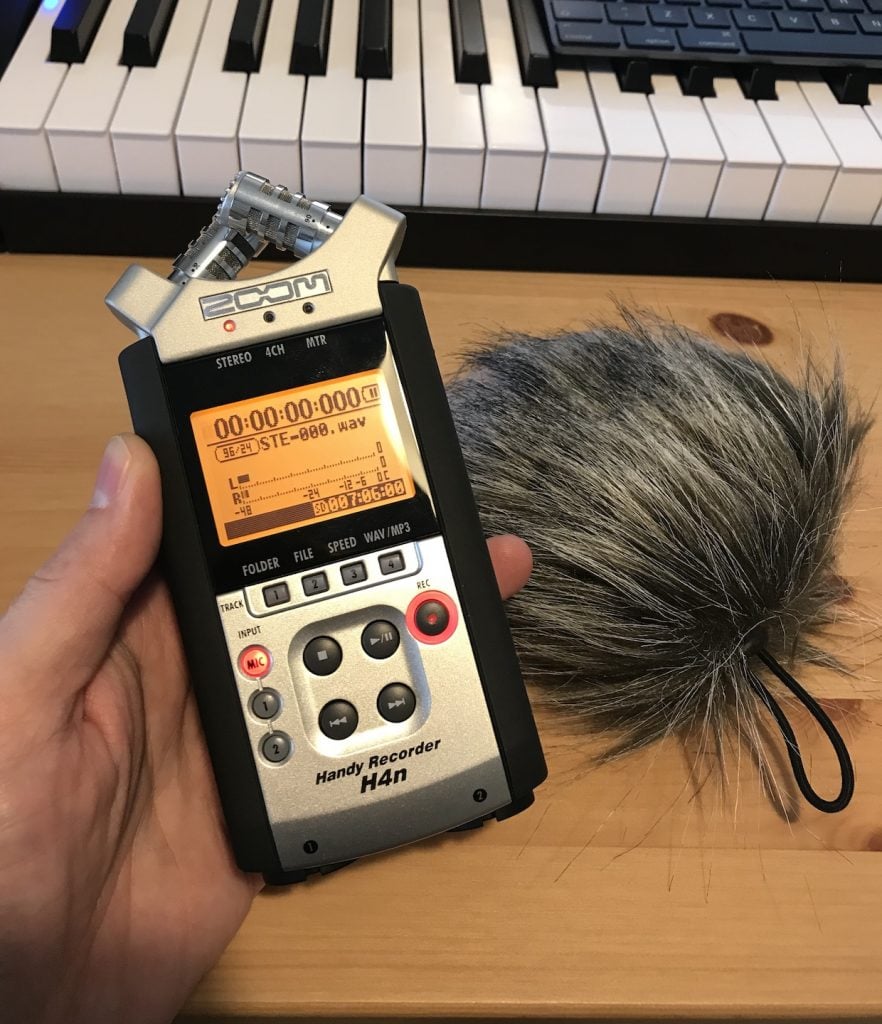
My Zoom H4n, with its included wind shield – I bought this when I started getting into sound design and I love it.
I bought this specifically to record audio for sound effects and I used it to record all of the sounds for my free Western Audio pack portfolio project.
Because it’s so portable it made recording objects in and out of the house so much easier. I used it to record my own footsteps, my garden gate, cups, glasses, wooden chairs.
I just wandered around the house recording things I thought might work.
It was great because the portability meant no set up time (compared to using a laptop, audio interface and an XLR microphone).
As a beginner, this was especially useful.
Learning how to record and produce sound effects involves a lot of trial and error. Some objects that you think would make a certain type of sound, just don’t.
Maybe it clips when you’re recording, or it’s too quiet. You might spoil the recording because who knew how noisy their clothes were!
Or… and this has happened a lot… the dog barks.
Except for that one time I needed him to bark.
What I’m trying to say is that, often, the quickest path to getting better is through experimentation and practice. Which was much, much easier with a portable recorder.
The model I bought has since been replaced, which is good because it now comes with better, quieter, preamps (one of the only complaints about the original model).
If I were to buy a portable recorder today, I’d buy this one without hesitation.
What about USB microphones?
Although I’ve never used a USB microphone myself, it’s difficult to ignore how convenient and affordable, they are.
Especially when you consider that, because it’s USB and not XLR, you don’t need to also buy an audio interface.
This brings the total cost down significantly and makes it much more accessible if you’re just starting out in audio design or if you don’t do much work in audio anyway.
An option similar to my beloved NT1 would be its USB equivalent, the NT USB.
But are USB mics good enough for recording sound effects?
If you buy from a reputable brand, the quality of an equivalent USB microphone is likely to be similar.
The differences to look out for are more likely to be found in the quality of the analogue to digital conversion (something that’s normally handled by the audio interface) and the available bit depth and sample rates available.
Generally speaking, a traditional XLR mic with a good audio interface is more likely to offer a better audio quality in most cases.
But, there’s no need to be a snob about it.
If a USB mic, by being more affordable and more accessible, helps you get started recording audio and experimenting with sound then that’s the best mic for you to buy, go for it.
It’s completely fine to use whatever you have available if the alternative is doing nothing at all.
Summary: How to get decent sound effects for your game
While there are many, many, options for making, editing and buying sound effects available to you, some of them are definitely better than others and, of the ones that are good, some may suit you and some may not.
If you need sounds quickly and easily, just buy some, there are some excellent products available and you’ll be adding sounds to your game in no time.
If you want something unique, or you have special requirements, source audio can provide infinite possibilities, so long as you don’t mind doing a little editing.
Or, if you want to try your hand at recording audio yourself and making sound effects from scratch it can be surprisingly affordable (and fun).
And if you don’t want to do any of that… I’ll help you out.
Got a great tip?
If you know of a great resource for game audio, tell me about it so that I can go try it.
I’ll continue to expand this list with more links, resources and recommendations so let me know what you’re using by leaving a comment below.
Image Attribution
How this content was created
This article was written using first-hand research and experience, without the use of AI. For more information on how Game Dev Beginner articles are written, see my writing policy.
